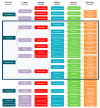Impact of Protein Intake in Older Adults with Sarcopenia and Obesity: A Gut Microbiota Perspective
- PMID: 32751533
- PMCID: PMC7468805
- DOI: 10.3390/nu12082285
Impact of Protein Intake in Older Adults with Sarcopenia and Obesity: A Gut Microbiota Perspective
Abstract
The continuous population increase of older adults with metabolic diseases may contribute to increased prevalence of sarcopenia and obesity and requires advocacy of optimal nutrition treatments to combat their deleterious outcomes. Sarcopenic obesity, characterized by age-induced skeletal-muscle atrophy and increased adiposity, may accelerate functional decline and increase the risk of disability and mortality. In this review, we explore the influence of dietary protein on the gut microbiome and its impact on sarcopenia and obesity. Given the associations between red meat proteins and altered gut microbiota, a combination of plant and animal-based proteins are deemed favorable for gut microbiota eubiosis and muscle-protein synthesis. Additionally, high-protein diets with elevated essential amino-acid concentrations, alongside increased dietary fiber intake, may promote gut microbiota eubiosis, given the metabolic effects derived from short-chain fatty-acid and branched-chain fatty-acid production. In conclusion, a greater abundance of specific gut bacteria associated with increased satiation, protein synthesis, and overall metabolic health may be driven by protein and fiber consumption. This could counteract the development of sarcopenia and obesity and, therefore, represent a novel approach for dietary recommendations based on the gut microbiota profile. However, more human trials utilizing advanced metabolomic techniques to investigate the microbiome and its relationship with macronutrient intake, especially protein, are warranted.
Keywords: gut microbiota; obesity; older adults; protein; sarcopenia; sarcopenic obesity; short-chain fatty acids; skeletal muscle.
Conflict of interest statement
The authors declare no conflict of interest.
Figures
References
-
- Sigit F.S., Tahapary D.L., Trompet S., Sartono E., van Dijk K.W., Rosendaal F.R., de Mutsert R. The prevalence of metabolic syndrome and its association with body fat distribution in middle-aged individuals from Indonesia and the Netherlands: A cross-sectional analysis of two population-based studies. Diabetol. Metab. Syndr. 2020;12:2. doi: 10.1186/s13098-019-0503-1. - DOI - PMC - PubMed
Publication types
MeSH terms
Substances
LinkOut - more resources
Full Text Sources
Medical


